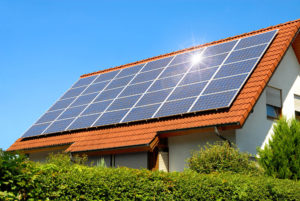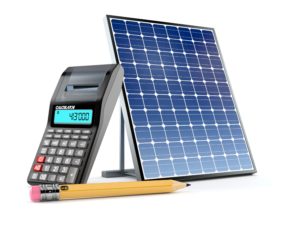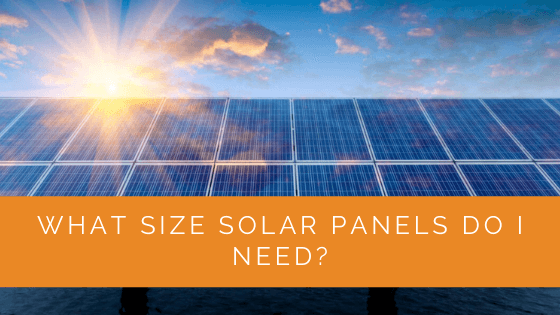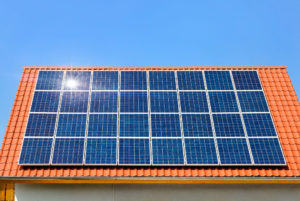Knowing the panel’s size is a must if you’re thinking of adding more solar panels to your solar system or setting up an entirely new setup. Understanding the size of solar panels you need will let you effectively utilise solar energy.
There are a lot of factors associated with selecting the correct panel size. You must check your electricity consumption, the number of appliances you’ll power, and the panel’s efficiency. The associated budget and roof space are also important factors to consider.
Whether you’re confused or need more help figuring out your system’s right solar panel size, you’ve landed at the right place. This post covers everything you need to know about solar panel sizing and helps you choose the right one. So, let’s jump right in!
Contents
- 1 Key Takeaways
- 2 Why is Solar Panel Size Important?
- 3 Factors to Consider While Determining the Solar Panel Size
- 4 How to Find Out The Correct Solar Panel Size?
- 5 How Many Solar Panels Will I Need?
- 6 Why Should I Get a Solar Battery?
- 7 Types of Solar Batteries
- 8 Case Study: Determining Optimal Solar Panel Size for a Residential Property
- 9 Expert Insights From Our Solar Panel Installers About What Size Solar Panels Do I Need?
- 10 Discover the Power of Solar with Solar Panels Network
- 11 To Sum Up
Key Takeaways
- Determining the right size for your solar panels is crucial for maximizing solar energy utilization and saving money on electricity bills.
- Factors to consider when determining solar panel size include your energy requirements, climatic conditions, available roof space, and budget.
- To find the correct solar panel size, contact a solar installation company for a precise assessment, use online calculators, or gather information about your location, roof characteristics, shade, and electricity consumption.
Why is Solar Panel Size Important?
Determining the size of solar panels is essential for maximum solar energy utilisation. It becomes even more crucial for those living in uneven sunlight or adverse climatic conditions. With the right-sized panels, you’ll be able to get the most out of your PV system.
Knowing the right size also lets you use your roof space properly. So, no more cramming multiple panels together. You can have a clean solar PV setup offering cleaner energy!
In general, solar panels that are generally used for homes are about 65×39 inches in dimension. Some solar manufacturers make 61.3×41.2 inches panels. You can also talk to some solar panel users about their panel sizes.
And how can you forget the money you save while figuring out all this? The right-sized solar panel will not only be more efficient, but it will be easier on your wallet, too.
Factors to Consider While Determining the Solar Panel Size
Want to reduce your carbon footprint and make the best of what Mother Nature offers? Then, going solar is the way to go. For those struggling with panel sizing issues, continue reading this section to get the required know-how.
Energy Requirements
The energy you need to produce is crucial in determining panel size. You must pick a panel as per the energy consumption of your residence.
For this, have a look at your electricity bill. Even if the document seems boring, look for your monthly consumption. Some electric bills will include the monthly value. If it isn’t there, divide the average value by 30 to get it. Similarly, divide the average daily consumption by 365 to find the yearly consumption.
Other tips for figuring out your monthly consumption –
- You can check out online electricity consumption calculators to determine your average and monthly usage.
- You can ask your electricity provider to check the meter readings and give you the exact value.

Climatic Conditions
Before purchasing a solar panel or setting up a solar system, take some time out and think about your weather conditions. While some areas bask in the sun throughout the year, some regions are not so bright.
So, the same solar panel installed in both regions will have different outputs.
Does this mean you need larger and more panels if you live in a gloomy area? Not necessarily. You must select the optimally sized solar panel according to the sunlight you receive.
Follow these steps to figure it all out –
- You first need to figure out the peak sunlight hours in your area. Usually, it is between 9 to 3 PM every day.
- Then, divide your daily consumption in kWh by the peak hours. You will then get the energy your panel needs to produce to meet your daily consumption.
- Multiplying this value by 1000 will give you the watt usage. You can use the value while buying the appropriately sized panel.
This vital information will also help you save time and money for the perfect panel size.
Peak Sun Hours
Peak sun hours are the daily hours when the sun’s intensity is highest. This intensity has to be 1000 watts per square meter or more in a peak hour. So, as the day reaches noon, the intensity increases, and so does your panel’s absorption.
The intensity will decrease by dusk, so charging your batteries and solar system earlier is better. Thus, to make things simpler while understanding a solar panel’s size, getting a better idea about the peak solar hours in your area is paramount.
Space
When it comes to selecting a panel’s size, making a note of the amount of space you have is extremely important. The area per square foot, orientation, and tilt of your roof/lawn will tell you the panel size it can handle.
Most users prefer to install four panels on the roof. So, if the average panel size is 1.6 square meters, you’ll require 6.4 square meters of roof space. Check out the following specifications –
- A 2 kW solar system might require 150 square feet of space approximately.
- A 3 kW solar system may need an estimated area of 220 to 225 square feet.
- For a 4 kW system, you might need a lot of space, about 301 square feet.
The expenses will vary for all these options, so you must carefully measure the area before selecting the panel. Consumers having ample roof space can install up to 12 panels for maximum efficiency.
Note: You also have to consider the direction of your solar array to get the most out of it. For instance, an East or west-faced solar PV array produces less output than a south-facing array.
So, if your roof is East or West faced, you might need a larger solar panel size for better efficiency and output.
Avoid obstacles like skylights, vents, and tree branches interfering with your setup.
Solar Battery Size
Every solar panel system needs a powerful battery to store the energy generated during the day for use at night. So, when you add a battery to your system, you have to factor in its size.
For example, the solar panel’s size won’t matter much if you need a battery to work as an emergency backup for a few hours. But, to run your home for more than 24 hours, you might want a powerful battery to store enough power. In that case, your solar panel system size will increase to keep the battery fully charged.
Surrounding Environment
Amongst all this technical stuff, you can’t forget your environment. Various obstacles in your environment might hamper your panel output. But why is this related to panel size? Let us understand.
If you live in an area filled with greenery, large trees may tilt on your roof, spreading the branches over your panels. Or, if tall buildings are adjacent to your house, it may hamper the amount of sunlight reaching your solar panels.
Both these factors prevent the solar panels from absorbing sunlight properly. In such cases, you may want to increase the panel size to compensate for energy losses.

Solar Power Losses
All solar power systems experience power losses. The loss percentage is small but can significantly affect your decision to select the right solar panel size.
Let’s check out the details –
- When DC electricity is transferred to the solar inverter, there is a system loss of about 2%.
- In addition, when the inverter converts DC electricity to AC, it suffers another power loss of approximately 3%.
- At the end of the day, you receive around 95 or 96% of usable electricity for running appliances and your home.
So, you must select an appropriately sized panel that can offer you the necessary power even after system losses.
Budget
Even after understanding all the technical nitty-gritty, your panel shopping depends heavily on your budget. If you have focused on all the factors discussed until now, you might have a rough estimate of the solar panel size you can afford.
You have to consider other factors too. For instance, if your roof isn’t too spacious, you might have to install more or larger panels. This will enable you to squeeze in more solar power.
On the other hand, you can install multiple panels if you have a higher budget and a spacious rooftop. A powerful battery and an inverter can set you up for good!
Note: Consider additional expenses such as buying equipment and expert consultation while preparing your budget. If you can survive some power losses while staying within your budget, go for that solar panel!
How to Find Out The Correct Solar Panel Size?
The best way to calculate a solar panel’s size is by contacting a solar installation company. You can check online for size calculation tools offered by many manufacturers. Or, you can directly contact the retailer.
Any reputed solar manufacturer will analyse your energy consumption needs and give you a free quote about the panel size. These calculations will be highly accurate.
In most cases, you can adjust the calculations per your requirements. However, to get the manufacturer’s most precise quote, you must do some digging. You may have to collect electricity bills for an entire year!
Is There a Simpler Way?
If you feel that contacting the solar manufacturer is tricky, you can check out Google. Online solar panel size calculators might do the trick for you. These portals will require you to enter the following details –
- Your home’s location
- The pitch of your roof
- Roof shade
- Your electric consumption
These tools will give you an idea of the various solar panel sizes that fit your home. With the sizing info, you might also get additional information such as annual savings, related expenses, and consumption.
How Many Solar Panels Will I Need?
While determining the optimum size for your solar panels, you also must check the amount you need. Let’s deep dive into this.
A 6 kW solar system will be perfect for homes with five or more residents. A 5 kW solar panel system will suit homes with four people or less. However, the most common solar system size is 4 kW, which can support a home of 3 to 4 people.
Now, we’ll get to the size and the number of panels –
- For a 3 kW solar system, 12 panels will suffice. Twenty-four panels will be suitable for a 6 kW solar panel system.
- The solar panel size will also depend on whether you want to power your entire residence or just a portion.
- So, if you want to go full-solar, the size and the number of panels will increase automatically. On the contrary, fewer panels can handle a percentage of your electricity needs.
So, look closer at the number of people at your residence and your electricity needs before narrowing down upon a panel size.

Why Should I Get a Solar Battery?
The whole point of figuring out the correct solar panel size is to enhance your energy savings. As we have already discussed the solar battery size, you might think, “Is getting a battery necessary?”
Buying a powerful solar battery will reduce your dependence on the grid. You also won’t have to worry about purchasing multiple panels to increase the system size. A battery will help you stabilise your power consumption.
Other advantages of buying a solar battery include:
- You can store the unutilised energy without returning it to the utility grid.
- Solar batteries are environmentally friendly and don’t cause too much pollution.
- They can help you reduce your electricity bills significantly.
The money you save by installing solar panels and a battery depends on the battery discharge rate and solar panel size. Therefore, your solar panel’s size and the type of battery you choose are interrelated.
Types of Solar Batteries
Properly utilising your rooftop space and keeping things under your budget will be possible by choosing the right type of solar panel. The two main types of solar panels you will come across are monocrystalline and polycrystalline.
Monocrystalline Solar Panels
These panels have a high-efficiency rate of 15 to 20% and are the most popular. They don’t take up too much space for installation and generate maximum usable energy. These panels can generate 10W more than others for one square metre.
Due to such unique features, they are a bit expensive.
Polycrystalline Solar Panels
These solar panels have 15 to 17% efficiency and are more temperature tolerant than monocrystalline panels. So they generate a little more energy throughout the year.
Although less expensive, they take up more space than monocrystalline solar panels.
Case Study: Determining Optimal Solar Panel Size for a Residential Property
Background
Solar Panels Network was approached by a homeowner in North England who sought to reduce their electricity bills and environmental footprint by installing a solar panel system. The primary objective was to determine the optimal size and number of panels needed to meet the household’s energy requirements without overspending.
Project Overview
The client wanted to cover their entire electricity consumption through solar energy, with an emphasis on sustainability and efficiency. The challenge was to accurately assess the household’s energy needs, the roof’s capacity, and the local climatic conditions to recommend the most appropriate solar panel size.
Implementation
- Energy Consumption Analysis: We conducted a detailed analysis of the client’s electricity bills over the past year to understand their energy consumption patterns.
- Site Assessment: A site visit was performed to measure the available roof space and assess any potential shading issues from surrounding trees and buildings.
- System Design: Based on the data, we designed a system comprising monocrystalline panels due to their higher efficiency and space-saving benefits.
- Installation: The installation included the setup of scaffolding, secure mounting of the panels, and integration with the home’s existing electrical system. The panels were installed with optimal tilt and orientation to maximise exposure to sunlight.
- Monitoring Setup: A monitoring system was implemented to track energy production and usage, providing real-time data and insights.
Results
- Energy Offset: The installed system was projected to cover approximately 90% of the household’s annual electricity needs, significantly reducing reliance on the national grid.
- Cost Savings: The client benefited from immediate reductions in electricity bills, with estimated savings of up to 70% annually. The investment was projected to be recouped within 6-7 years.
- Environmental Impact: The system prevented an estimated 3 tonnes of CO2 emissions per year, contributing to the client’s sustainability goals.
- System Performance: The monitoring system ensured optimal performance by identifying and addressing any issues promptly, maintaining high efficiency even in less sunny months.
Summary
The successful sizing and installation of the solar panel system provided the homeowner with a substantial reduction in electricity costs and a significant decrease in their carbon footprint. This project underscores the importance of precise energy assessments and careful planning in determining the right solar panel size. The case study illustrates how Solar Panels Network’s expertise can help homeowners achieve energy independence and environmental sustainability through tailored solar solutions.
Expert Insights From Our Solar Panel Installers About What Size Solar Panels Do I Need?
Choosing the right size for your solar panels is crucial not only for efficiency but also for cost savings. A well-sized system can ensure you’re not overpaying for energy you don’t need or underestimating your consumption.
Lead Solar Consultant
Determining the correct solar panel size involves a thorough assessment of your household’s energy usage and available roof space. It’s about striking the right balance to maximise energy output without compromising on aesthetics or budget.
Senior Solar Technician
Peak sunlight hours and local climatic conditions significantly influence the size of the solar panels you need. A comprehensive evaluation ensures that your system performs optimally throughout the year, regardless of weather changes.
Renewable Energy Specialist
Discover the Power of Solar with Solar Panels Network
Are you navigating the world of solar installations? Look no further than Solar Panels Network, the UK’s trusted partner in harnessing the sun’s potential. Our dedication goes beyond just installations; we’re on a mission to transform how homeowners and businesses across the UK perceive and utilise energy. By choosing us, you’re reducing your carbon footprint and making a smart financial move that promises savings for years ahead. Contact us today and embark on your solar journey.
To Sum Up
It would be best if you had understood everything about a solar panel’s size by now. The right size is essential to generate the maximum energy while keeping your bills in check. It also prevents you from overspending on a panel that might not suit your needs.
Be sure to consult a solar technician or a manufacturer before making the final call. Whenever you get stuck, our handy guide will pull you out!
About the Author
Solar Panels Network stands at the forefront of solar energy solutions, driven by a team of seasoned solar engineers and energy consultants. With over decades of experience in delivering high-quality solar installations and maintenance, we are committed to promoting sustainable energy through customer-centric, tailored solutions. Our articles reflect this commitment, crafted collaboratively by experts to provide accurate, up-to-date insights into solar technology, ensuring our readers are well-informed and empowered in their solar energy decisions.


